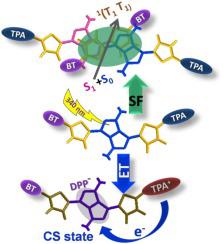Journal of Photochemistry and Photobiology A: Chemistry ( IF 4.1 ) Pub Date : 2020-11-04 , DOI: 10.1016/j.jphotochem.2020.113017 Madhu Chakali , Haraprasad Mandal , Munisamy Venkatesan , Bharath Dyaga , V. Jayathirtha Rao , Prakriti Ranjan Bangal

|
A covalently linked push-pull type triad containing two unsymmetrical electron donors, triphenylamine (TPA) and benzothiophene (BT), and diketopyrrolopyrrole (DPP), an electron acceptor, through thiophene spacer has been synthesized (BT-DPP-TPA(7)) and ultrafast relaxation dynamics of the triad has been explored in solution phase by various spectroscopic methods. Steady-state and time-resolved emission studies show the efficient fluorescence quenching of the DPP entity of as prepared BT-DPP-TPA(7) triad. The negative free energy values comprising the redox potentials and singlet state energy of BT-DPP-TPA(7) revealed the probability of electron transfer from the singlet ground state of TPA to the excited singlet state of DPP. Femtosecond transient absorption (fsTA) spectroscopic studies confirmed the formation of charge separation state by detecting triphenylamine radical cation as electron-transfer transients. The rate of charge separation, kCS, is (109−108 s−1) observed to be increasing from nonpolar to polar solvents and the rate of charge recombination, kCR, was found to be slower (μs time scale) in polar solvents like DMF and chloroform, than that in hexane, non-polar solvent (ns time scale). This novel aspect could be due to asymmetrically designed push-pull type triad, a feature that was not evident in push-pull triad constructed using symmetric TPA as electron donors. Furthermore, fsTA studies also demonstrate, for the first time, that the DPP derivatives, TDPP(4) and BT-DPP-TPA(7), both undergo singlet fission (SF) event (S→TT) in 100−200 ps time scale in solution phase for the solution of concentration above ∼100 μM. These results may pave the new avenue for device design comprising DPP derivatives.
中文翻译:

共价连接的二酮吡咯并吡咯衍生物和三苯胺三联体的电荷分离和单裂变
通过噻吩间隔基合成了包含两个不对称电子给体三苯胺(TPA)和苯并噻吩(BT)和电子受体二酮吡咯并吡咯(DPP)的共价连接的推挽型三重态(BT-DPP-TPA(7))在溶液相中已通过各种光谱方法探索了三重轴的超快弛豫动力学。稳态和时间分辨发射研究表明,准备好的BT-DPP-TPA(7)三单元组的DPP实体具有有效的荧光猝灭作用。包含BT-DPP-TPA(7)的氧化还原电势和单重态能的负自由能值揭示了电子从TPA的单重态基态转移到DPP的激发的单重态的可能性。飞秒瞬态吸收(fsTA)的光谱研究通过检测三苯胺自由基阳离子作为电子转移瞬变,证实了电荷分离状态的形成。电荷分离速率k CS为(10 9 -10 8 s -1),从非极性溶剂变为极性溶剂正在增加,并且电荷重组速率k CR较慢(μs时间标度)。极性溶剂(例如DMF和氯仿),而不是己烷中的非极性溶剂(ns时间标度)。这个新颖的方面可能是由于非对称设计的推挽式三重轴,这一特征在使用对称TPA作为电子供体的推挽式三重轴中并不明显。此外,fsTA研究还首次证明,DPP衍生物TDPP(4)和BT-DPP-TPA(7)都在100-200 ps时间范围内经历了单峰裂变(SF)事件(S→TT)。浓度高于〜100μM的溶液的溶液相。这些结果可能为包含DPP衍生物的器件设计开辟新途径。


















































 京公网安备 11010802027423号
京公网安备 11010802027423号